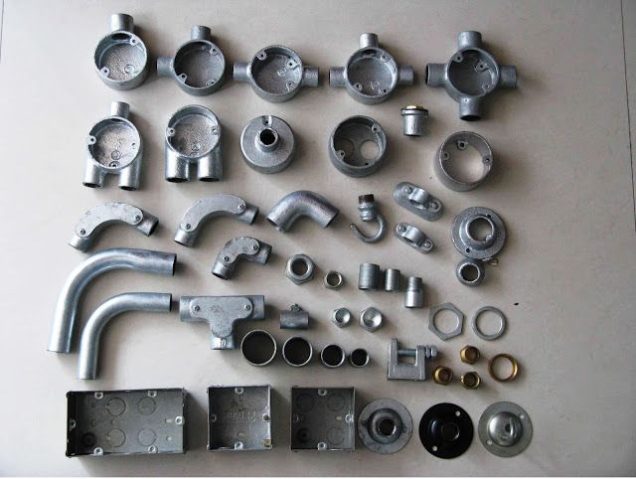An electrical conduit is a tube used to protect and route electrical wiring in a building or structure.
Electrical conduits are metal, plastic, or fiber pipes designed to protect electrical cables and wires. They’re used in just about every residential and commercial establishment, especially for wiring that is either exposed or fitted outdoors.
Types of Conduits
They can be broadly classified into metallic and non-metallic variants:
- Metallic Conduits
- . Rigid Metal Conduit – They usually have the toughest and thickest walls made from coated stainless steel or aluminum, so they offer excellent protection against impacts, punctures, and cuts.
- . Electrical Metallic Tubing – They are much lighter and bend easily, these are not technically conduits, they are classified as tubing. They are much thinner which makes them prone to breaking on impact; it is advisable to use them where they will get more stress.
- . Flexible Metallic Conduits – these are commonly known as Greenfield or flex conduits, they have high resistance to vibration. The downside is that they don’t offer much protection against impacts and corrosion, and cannot be used outdoors, buried, or embedded.
- . Liquid-tight Flexible Metallic Conduit – this is called liquid-tight and seal tight Conduits. They have a non-metallic outer cover which makes them resistant to roast on contact with water and they don’t break easily, they are still vulnerable to physical damage and should not be exposed to stresses, or encased in concrete.
- . Aluminum Conduits – Aluminium resists corrosion well. Aluminum conduits are preferred in locations where they would be exposed to large amounts of water or corrosive substances. They are, however, particularly vulnerable to concrete, since the metal reacts to it, but can be treated with specific coatings if they need to be embedded in concrete.
- Non-Metallic Conduits
- . Rigid Metal Conduits – They are one of the most commonly used conduits in commercial establishments. They usually have the toughest and thickest walls made from coated stainless steel or aluminum, so they offer excellent protection against impacts, punctures, and cuts.
- . Electrical Metallic Tubing – These are by far the most commonly used conduits, even though they’re not technically conduits at all (they’re actually classified as tubing). They are usually called ‘thin walls’, since they have a much thinner wall, which is why they should not be used in places where they’re likely to encounter stress.
- . Flexible Metallic Conduit – Commonly known as ‘Greenfield’ or ‘flex’ conduits, they are made from spirally wound metal strips that interlock. They’re most often used for the last few feet of wiring, where conventional conduit systems are difficult to maneuver and terminate. Another great advantage is their ability to absorb vibrations and allow movement, so they’re often used to house wiring for pumps, motors, and manufacturing equipment.
Conduit Fittings
Conduit fittings are available in a huge variety of sizes, shapes, and materials, and they’re normally used for connecting runs of conduit together, and for connecting conduit ends to boxes, enclosures, or electrical devices.
Types of Fittings
- Conduit Bodies:
These are tubular units with openings at each end for admitting conduits and providing access to the wires.
- Bends:
They are commonly called ‘factory bends’ or ‘elbows’, they are available in a variety of lengths and curvatures, you can bend certain tubing by hand, using a mechanical bender, or a hydraulic bender for larger ones.
- Coupling:
Conduit couplings are essential for almost any coupling system, for securely linking together lengths of conduit and attaching site-fabricated bends. Couplings are available in a variety of sizes and some of them, like rigid conduit couplings, are threaded on the inside.
- Drains:
In areas where the temperature varies significantly, or the conduit runs from a warm area to a cooler one, moisture in the air starts condensing. To prevent drips and water-logging in the conduit runs, install drains at the lowest points of each run that might be affected, or at locations where water might get trapped and accumulate.
- Bushings and Locknuts:
Bushings create a smooth entry point to conduits without any sharp edges, protecting the conductors from damage during wire pulls. They are also extremely important when the conduit system enters an enclosure or bus box.
- Unions:
Conduits often run along with areas where space is constrained and couplings are difficult to install. Apart from that, sections might at some point get damaged, which is where unions are very useful. They have two separate heads and a locking mechanism that can connect two pieces of conduit together, even if they can’t be physically turned. Unions are available in different configurations with male and female heads, or a combination of both.
- Nipples and Hubs:
Nipples can save time and money when a conduit is needed between enclosures that are placed close to each other, or for short runs where field-threading the ends of a conduit is difficult.
Hubs are used to connect conduits to bus boxes or enclosures that don’t have a factory-threaded entry.
- Reducers and Reducing Washers:
A reducer is a special kind of combination coupling that allows you to connect raceways of one trade size to larger or smaller ones.
Reducing washers, or threaded reducers, are similar to hubs, except both the inner and outer surfaces are threaded. They are used to connect conduits to enclosure or box openings that have a larger diameter, with locknuts on both sides to fasten them in place.
- Staps and Clamps:
Straps are used to mount the conduit to ceilings or walls using screws or bolts. To fasten conduit runs to fixed structures, like beams, hangers or unistrut channels, the conduit is supported using clamps.
For more information or assistance during normal business hours, call or e-mail TPS at the phone number above. You can also complete and submit our Service Project Inquiry form.

